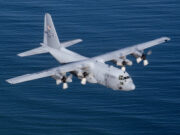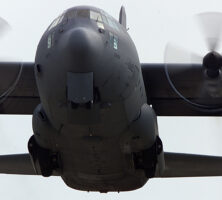Georgia is home to one of the most versatile and rugged transport aircraft ever built: the C-130 Hercules. First flown in 1954, more than 2,200 of the aircraft have been produced in seventy different versions for sixty different countries. The latest model, the C-130J, remains in production at the Lockheed Martin facility in Marietta.
With a wide fuselage, distinctive high tail, and multiwheeled landing gear, the C-130 can operate from virtually any runway, including rough dirt airstrips. Equipped with skis, C-130s regularly fly supply missions to Antarctica, and in an unusual test, a modified C-130 once landed on and took off from an aircraft carrier. Beyond its role as a versatile cargo and troop transport, C-130s are used as bombers, cannon-firing gunships, hurricane hunters, aerial refueling tankers, air ambulances, firefighters, and even aerial sprayers. A commercial version, known as the L-100, has also been produced.

The four-engine C-130 Hercules began after World War II (1941-45) with a government specification for a new type of cargo aircraft designed for rapid loading and unloading of soldiers, cargo, and vehicles, including helicopters. The aircraft’s high tail allows room for a large cargo door that lowers to form a ramp. With a length of 97 feet and wingspan of 132 feet, the C-130J can carry up to 46,631 pounds. In troop transport configuration, it can accommodate 92 combat troops or 64 paratroopers. The aircraft can fly up to 2,729 miles and has a maximum speed of 417 miles per hour.

Though the C-130J in production today resembles the C-130A that went into service in 1956, there are dramatic differences. The newest model relies heavily on computers and electronic displays. Its four Rolls-Royce turboprop engines turn six-bladed propellers that deliver significantly more power than earlier engines, allowing it to fly and climb faster, cruise at higher altitudes, and carry a larger payload.
More than 145 C-130s were used in Operations Desert Shield and Desert Storm in the early 1990s. During the war against terrorism in Afghanistan (2001- ), C-130s again played a key role, with the gunship AC-130 model used for close support of ground troops.
Perhaps the most unusual mission ever envisioned for the aircraft involved modification of a C-130H to include downward-facing and forward-facing rockets that would have allowed it to land and take off almost like a helicopter. Had the plan been carried out, the aircraft would have landed and taken off inside a Tehran, Iran, soccer stadium to rescue U.S. hostages.
In the United States C-130 aircraft are used by the U.S. Air Force, the Air National Guard, the U.S. Air Force Reserve, and other government agencies. If the C-130J in production at the start of the twenty-first century provides a service life equivalent to earlier models, the C-130 design will be flying well into the 2030s, more than seventy years after it first left the drawing board.








